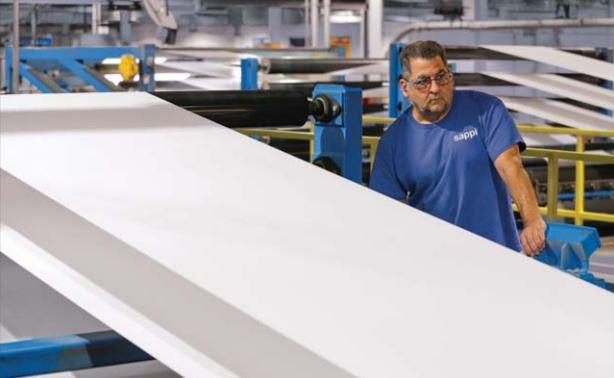Sappi's Allentown Facility Carries "Zero Waste" Mission
Sheeting facility generates one pound of waste per paper ton

Sappi’s Allentown sheeting facility generates just one pound of waste for every ton of paper processed, well below industry standards for zero waste designations. With great planning, execution, and a strong vision of how recycling can lower costs and bring in new revenue, Allentown’s range of materials re-used or recycled is impressive.
Allentown’s sheeting operations stand out as an excellent example of an industrial process that’s efficient, flexible and generates nearly zero waste.
Allentown currently can sheet and package 110,000 tons of paper per year utilizing three sheeters. It also operates carton and shrink wrap packaging lines and other converting support equipment. Allentown’s Operations Manager, Mark Wagner, is proud of the waste reduction and recycling accomplishments of his team.
“We recycle and reuse soft-white broke, hardwhite broke, offi ce paper, corrugated cardboard, kraft wrap, and kraft headers,” says Wagner. “All of our cores are recycled; some to be re-pulped, while some end up being used to make cat scratching posts and climbing trees. Core plugs are resold, sawdust is used in bedding for small animals, pallets and other wooden items are recycled into mulch and compressed wooden heating pellets, and are also used in making silt socks. We recycle shrink wrap, kraft air bags, and polywoven dunnage air bags.”
Landfill costs, including those incurred delivering and exchanging containers, average $90 per ton, so every pound of material that is sent out to recycling rather than to landfi ll represents savings to the company’s bottom line. The team also identifi es markets for some materials to be recycled or re-pulped, creating revenue streams for “waste” paper. The small amount of waste that Allentown does send to the landfi ll represents materials that as of yet can’t be recycled or resold—like food items from lunches, and some material not generated at the facility.
Meeting higher customer standards, lowering landfi ll costs, and identifying new uses and new revenue streams for industrial byproducts is a Sappi North America hallmark. “Allentown most likely could qualify to be certifi ed as a ‘zero waste’ facility based on our very low rates of landfi ll waste. That is impressive,” Wagner says. “But what is even more impressive is that we didn’t need a standard to motivate us. We were already focused on reducing waste and recycling. We are always striving to improve, and challenge ourselves with new ways of reducing waste and that is what makes me so proud of the operations and our performance.”
Read more from Sappi North America's 2017 Sustainability Report here: http://bit.ly/Sappi-SR17

